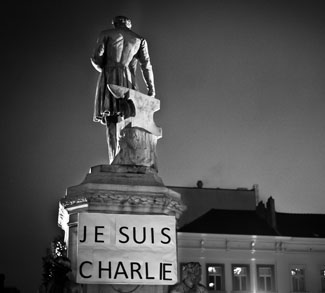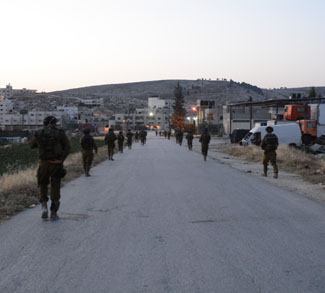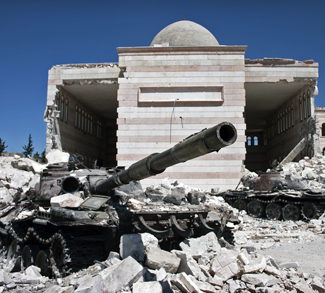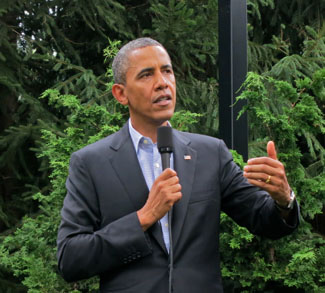The Islamic terror attack on the offices of the French satirical weekly Charlie Hebdo has prompted spirited defenses of freedom of expression from the French government and its Western allies. Charlie Hebdo first came onto the radar of Islamist organizations in February 2006, when it reprinted the famous “Mohammed cartoons” that had first been published by the Danish daily Jyllands Posten several months earlier. The French paper even added a Mohammed cartoon of its own, and it has since repeatedly caricatured the Prophet Mohammed in its pages.
The Western defense of freedom of expression in the face of attacks by Islamic fundamentalists has not always been so unequivocal, however. Indeed, from the start of the Mohammed cartoon controversy, the support of some Western governments – including the French – for Jyllands Posten, Charlie Hebdo and other “offenders” has been tepid at best. For instance, far from defending the rights of Charlie Hebdo upon the paper’s publication of the cartoons in 2006, then French President Jacques Chirac promptly denounced what he termed as “obvious provocations” and warned that “anything that could offend other people’s convictions, in particular religious convictions, should be avoided.”
In this debate between classical Western freedoms and notions of Islamic piety, one of the few French leaders to clearly come down on the side of the former was then Interior Minister Nicolas Sarkozy. “All told, I prefer too much caricature to too much censorship,” Sarkozy dryly remarked.
Nonetheless, it was precisely under the presidency of Nicolas Sarkozy five years later that France would lead its NATO partners into adopting a policy with even more fateful consequences, not only for the freedoms of its citizens and allies, but for their very security as well.
In opting to throw the might of the Western alliance behind the Libyan rebellion against Muammar Gadhafi, NATO joined forces with a Libyan opposition whose Islamist convictions were obvious from the start. Indeed, unbeknownst to most Western observers, the anti-Gadhafi rebellion had roots precisely in the protests against the “Mohammed cartoons” that in February 2006 had engulfed the Muslim world, including the future “capital” of the rebellion, Benghazi.
One need not look very far for corroborating evidence – the very name of the anti-Gadhafi rebellion alludes to it. The rebellion is officially known as the “February 17 Revolution,” in honor of the Feb. 17, 2011 protests in Benghazi that served as its spark. But the 2011 protests were originally scheduled to commemorate protests that took place in Benghazi five years earlier, on Feb. 17, 2006; protests, namely, against the caricaturing of Mohammed.
Those 2006 protests quickly spiraled into a violent siege of the Italian consulate in the city. Two days earlier, at the height of the Mohammed cartoon controversy, Italian politician Roberto Calderoli, then a member of the Italian government, had appeared on television wearing a t-shirt with a Mohammed cartoon printed on it. Calderoli’s gesture was widely reported in the Arab media, and on Feb. 17, following Friday prayers, thousands of young men descended upon the consulate from Benghazi’s mosques. The building was soon set ablaze and assailants repeatedly attempted to break down the door. After tear gas failed to disperse the rioters, Libyan security forces opened fire, killing 11 people. The incident would become a cause célèbre in local opposition circles.
In March 2011, NATO would come to the rescue of these same opposition circles as Libyan army forces amassed around Benghazi, threatening to stamp out the incipient rebellion. Interpreting its UN mandate in an implausibly expansive manner, NATO would then go on to provide air support as this opposition, now transformed into a rebel army, began to turn the tide and march toward Tripoli. In short order, a full-fledged NATO-Islamist alliance would be forged in Libya. Massive NATO bombing of Tripoli in August would finally open the gates of the Libyan capital to rebel forces.
By facilitating the triumph of the Libyan rebellion in this way, NATO strengthened some of the most radical currents in the Muslim world: some of the very currents that, as the history of the 2006 Benghazi riots shows, had taken the West violently to task over the Mohammed cartoon controversy. It was only after the fall of Sirte, the last stronghold of the old regime, and the killing of Muammar Gadhafi that the Western public would first get some inkling of the reality of the situation. On October 23, 2011, two days after Gadhafi’s death, the political head of the rebellion, Mustapha Abdul Jalil, proclaimed the “liberation” of Libya and, at the same time, the abrogation of all Libyan laws contradicting the sharia.
It was inevitable that such a policy would produce strategic blowback. The first and most direct instance was, of course, the Sep. 11, 2012 attack on the US diplomatic mission in Benghazi. Conservative American commentators have gone to great lengths to insist that the attack was a terror attack by al-Qaeda-affiliated elements and had nothing to do with the would-be satirical “Innocence of Muslims” YouTube video that was causing outrage in the Muslim world at the time. Their implicit assumption is that the attack must either have been a terror attack or motivated by the anti-Islam video, but could not have been both. If not already the case before, the Charlie Hebdo attack will make it obvious that this assumption is bogus. In any case, though the Benghazi attack was surely carried out by seasoned jihadists, it is equally true that the anti-Islam video is what motivated them to act when they did.
The Benghazi attack might have served as a wake-up call for the West. Instead, France, the United States, and their NATO partners went on to adopt essentially the same policy of supporting Islamist rebels in Syria. Even as NATO has gone on to declare war on the “extremists” of the Islamic State, virtually all the rebel groups that have at one time or another been touted as “moderates” by Western policymakers have made no qualms about their fundamental Islamist principles and their eagerness to collaborate with Al-Qaeda’s official Syrian affiliate, Jabhat al-Nusra. This holds as much for the members of the “Islamic Front” in and around Aleppo as for those of the “Southern Front” in the vicinity of Daraa. By yet again facilitating Islamist rebellion in Syria, the West provided still further impetus to the most radical currents in the Muslim world, permitted jihadist strongholds to be carved out of Syrian territory, and precipitated an exodus of young Muslims from Europe to Syria to partake in jihad.
The exact itineraries of the Kouachi brothers, the perpetrators of the Charlie Hebdo attack, remain murky. But it is obvious that they and their associate Amedy Coulibaly, perpetrator of the deadly hostage-taking at Paris’s Porte de Vincennes, all belonged to the same broad movement whose development Western policy has thus far favored. Indeed, two further associates of the trio – Coulibaly’s companion Hayat Boumeddiene and a mysterious “fourth man” who may have been an accomplice to both massacres – are reported to have fled to Syria.
It remains to be seen whether the Charlie Hebdo attack will finally cause Western leaders to reconsider.
John Rosenthal is a guest contributor to Geopoliticalmonitor.com, and author of The Jihadist Plot: The Untold Story of Al-Qaeda and the Libyan Rebellion.




